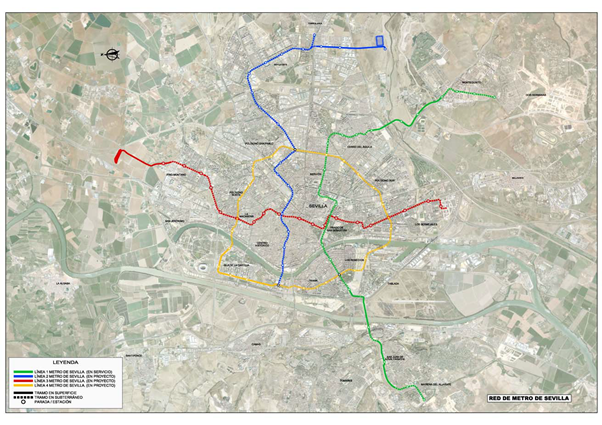Why Sevilla - part three
Posted on 7th March 2024 at 17:06
This year’s European Light Rail Congress is being held in the beautiful city of Seville in Spain. Capital and the largest city of the Spanish autonomous community of Andalusia, it is known for being the warmest city in Continental Europe with temperatures regularly exceeding 35 degrees in July and August. Since 2009, it has also been the home of the Global Light Rail Award winning Metro de Sevilla and their 18.1km of light rail.
To explore why we will be visiting thid fine city and to give you an idea of the who, what and why of Metro de Sevilla, we have prepared this special series of blogs.
In this part, we explore the Metro lines both current and in development...
Since its opening in 2009, Metro de Sevilla’s Line 1 has proven a popular choice not only with the city’s residents but also as an alternative urban travel choice for its metropolitan residents. The operator and its parent company, Globalvia, are always looking for ways to improve their service, optimise the passenger experience and encourage sustainable forms of transportation within the city. Therefore, it is no surprise that, given the ridership of the system – 20 million passengers in 2023, that it is due to expand with the creation of two new lines. These lines will help the service to maximise its capacity and to offer a wider service to its customers.
Line one was opened in 2009, is 18 kilometres long and hosts 22 stations. The line runs from east to west and passes by the Sevilla FC stadium and the city’s university. It was originally envisioned as a way to facilitate the flexible movement of the populace across the city and is currently undergoing expansion – some of which will be available to view as part of the European Light Rail Congress in 2024.
Metro Line 2 will run from east to west however it will be placed further north than Line one. It is currently the subject of a study by the Ministry of Development, Territory and Housing and it die to have an operation length of approximately 11.5km. The line will be double track and will operate both underground and on the surface. Adding another 17 stations to the current network, it will help significantly boost access to sustainable transport across the city.
In addition, a third line is being planned which will connect the north of the city with its city centre and is expected to directly benefit a further 120,000 inhabitants of the Metropolitan area of Seville. This line will serve to considerably help reduce congestion on the city’s roads as well as boosting the city’s public transport offering to its citizens.
The line was first agreed in 2022 and required an investment of around EUR1.36m (GBP 1.16m) and is designed to operate both above and below ground. The Northern section of the line will stretch for 7.55km and will consist of mainly double track, have one surface station and 11 underground stations as well as being connected to the necessary workshops and depots to maintain an efficient fleet. With an estimated journey time of 18 minutes, it is hoped that this line will not only increase capacity but also serve as an effective alternative to car transport across key sections of the city. The line is hoped to be completed in 2030.
The Southern Section of the line will measure 8.0km, use double track and will link the Northern Section to the southern end of the city within an approximate time of 21 minutes. The objective of this line is to strengthen the intermodal connectivity of the different public transport systems that already exist such as Line 1 of the Seville Metro, the bus network and the Metrocentro tram system.
It certainly is an exciting time to be in Seville and, as a city dedicated to sustainable transport and supporting integrated urban transit, it is no surprise that they are the hosts of the 6th European Light Rail Congress. With an opportunity to not only hear from them on their latest plans and operations, the status of the latest extensions as well as an opportunity to look around the Metro de Sevilla depot for yourself, there has never been a better time to place yourself and your organisation at the heart of European LRT.

An image of the projected Metro de Sevilla lines once completed (Metro de Sevilla)
To learn more about the 2024 European Light Rail Congress and how you can get involved as a delegate, supporter or exhibitor, please click here…

Share this post:

